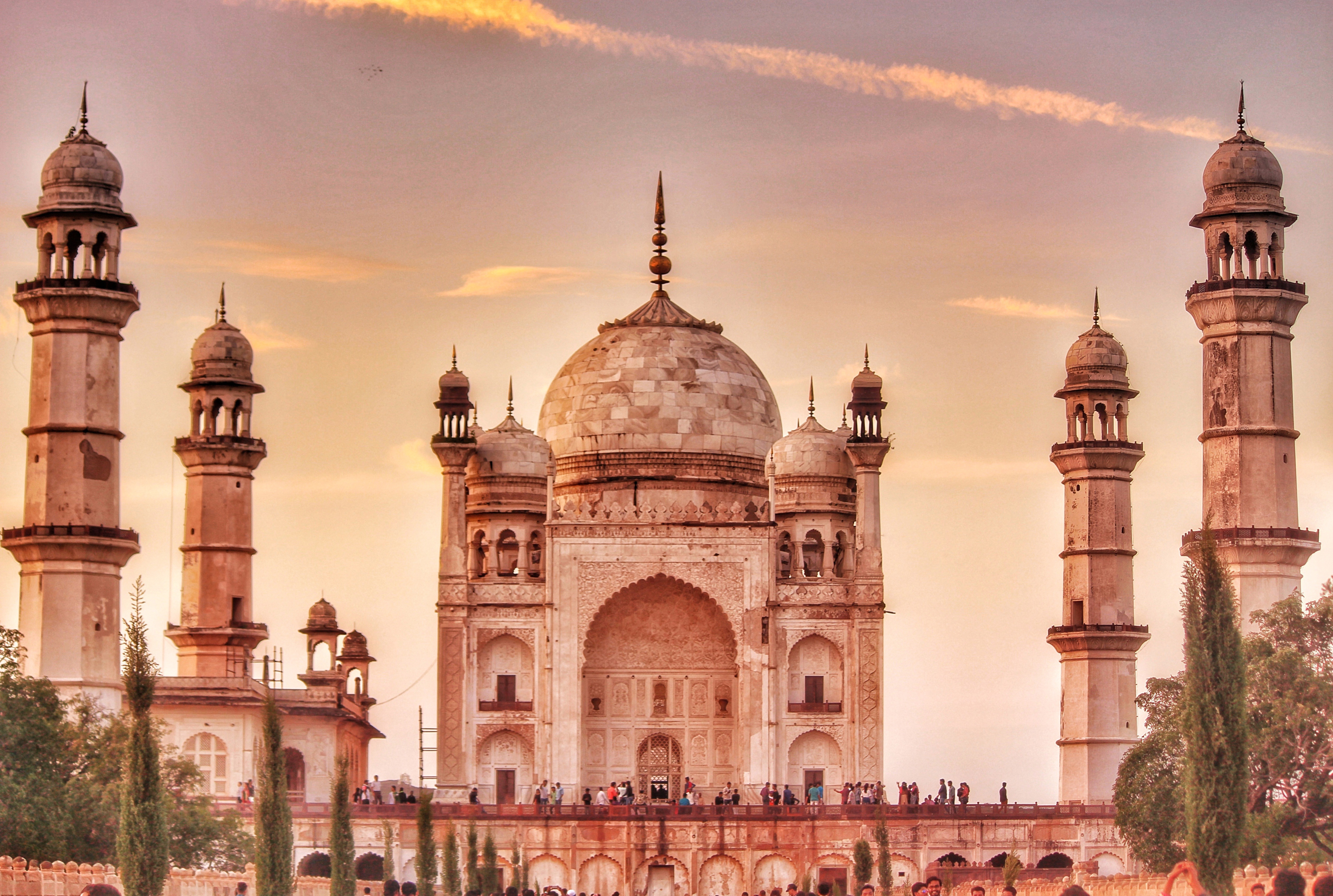
Aurangabad
Aurangabad is a compact wonderland of Buddhist cave monuments, making it a perfect place to explore the history of religion in India. With some of the finest surviving examples of Indian art, especially paintings, the caves are recognized by UNESCO as a leading heritage site. Aurangabad can be reached easily via the nearest railway station in Jalgaon, and the caves are further south, 150 kilometers from there.
Aurangabad is an easily explored area with every scenic location conveniently located right in the middle of the city, so travelers on a fixed schedule can see a lot in a short time.
The Ajanta Ellora cave area, with their idyllic location and evergreen surroundings, represents Aurangabad’s heart. Further north, the landscape gets crowded, with Grishneshwar Jyotirlinga Temple and Bibi Ka Maqbara offering hints of diversity in the culture. In between lies Aurangabad’s shopping district – perhaps not glamorous, but very fascinating and colorful.
Places to Visit in Aurangabad:
Ajanta Caves: For followers of history, a visit to Ajanta Caves is a must. Whatever you do in Aurangabad, do not miss this. Made to commemorate Buddhism in India, these prehistoric caves have been preserved in their entirety by the Archaeological Survey of India and are a very enlightening monument. The tour runs for a minimum of 2 hours, but the substance and history of every carving might tempt you to spend some more time understanding the chain of events. Due to the rush from locals on weekends, it is advisable to visit the caves on weekdays. If possible, make the trip early in the morning to see the place without the crowd and more of fresh air. The caves open at 9:00 am every day. In between them, there are steps and some climbing, but it is not tedious. Ensure to carry sufficient water while entering the caves as you won't find anything inside. While on the tour, you might feel that the paintings or carvings look familiar, but each of them has a different story to tell. You can also hire local guides who can take you through the entire story of how these were built and what the government is doing now to preserve the caves.
Ellora Caves: Ellora Caves are at their best during the monsoon months of July-September when the nearby landscape is lush green. The heritage and skill of ancient craftsmen are captured in Ellora caves incredibly. The 1500-year-old sculptures look so rich with expressions that it’s difficult to imagine they were made that long ago. According to the stories on how Ellora was made, it is said that almost 70,000 tons of rocks were removed just to make Cave 16, where the main Shiva Temple was built. Though the caves are spread over hundreds of acres, only the ones near the mainland are accessible. Personal vehicles are not allowed inside the complex, so once you reach the entrance, you can take an auto.
Grishneshwar Temple: As one of the 12 jyotilingas of Shiva, the Grishneshwar Temple is located just outside the Ajanta Ellora caves. The layout and architecture of it are absolutely stunning and noteworthy. It has multiple stories, each one dedicated to a different ritual. One of the legends speaks of Parvati, born as a tribal woman, wooing the Lord and being united with Him here. It is said that one day, as she ground vermillion and saffron with water to apply on the parting in her hair (a symbol of the married woman), Shiva, in the form of light, appeared in her palm. This light turned into a lingam, which she called “Grishneshwar”, as it was formed by the friction (Grishna) between her finger and palm. The temple was rebuilt in the 16th century and is at its best early in the morning. The life at this side of Aurangabad starts late, so if you fancy going without milk or flowers, early morning is a crowd-free time to have darshan. Grishneshwar Temple is located about 27 km from Aurangabad.
Jain Temple: Located at a distance of 35 kilometers from Aurangabad, the Jain Temple is a very neat place to visit. It has a gold-plated idol of Digeshwar, which is said to have some miraculous power. People from nearby areas visit the temple regularly to stay in touch with the intricacies of their religion.
Jayakwadi Dam: Part of a huge irrigation project, the Jayakwadi Dam is a beacon of hope for the drought-prone area in Maharashtra. It is around 41.30 meters tall and 9,998 m (10 km approx) wide with a storage capacity of 2,909 MCM (million cubic meters) and an effective live storage capacity of 2,171 MCM. The total catchment area of the dam is 21,750 MCM. There are a total of 27 water gates for the Dam. In the year 2015, it entered its 41st year of operation. It has, in its lifetime, overflowed only 17 times. The Dam is a great place to come out for a picnic with young children. The drive from Aurangabad sometimes takes a longer time due to poor roads.
Aurangabad has some very ethnic shopping areas. People come here to buy Paithani silk sarees, woven silk Himru and Mashru shawls, of which Himru is an age-old weaving craft of Aurangabad with a blending of cotton and silk that gives a feel of satin. Aurangabad is also known for its bidriware, the intricate silver inlay craft that was once patronized by the Mughals. You can also find a wide display of jewelry made of semi-precious stones and decorative pieces in Aurangabad. It is also the place to look for old coins dating back to the Mughal period. Nirala Bazar, situated in the heart of the city, is a good place to shop if you are looking for branded showrooms. For a bargained shopping experience, Connaught Place is slowly coming up and is a hangout place for many youngsters. Paithan Gate is another good place to buy readymade clothes and shoes. City Chowk, as its name suggests, is the chowk (center) of the city, where most festivals and celebrations are held. Near the chowk is Buddi Lane, known for spicy and delicious non-vegetarian food
Interested in visiting Aurangabad? Click Here And Plan Your Vacation
